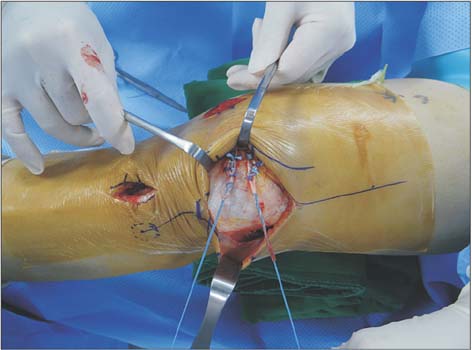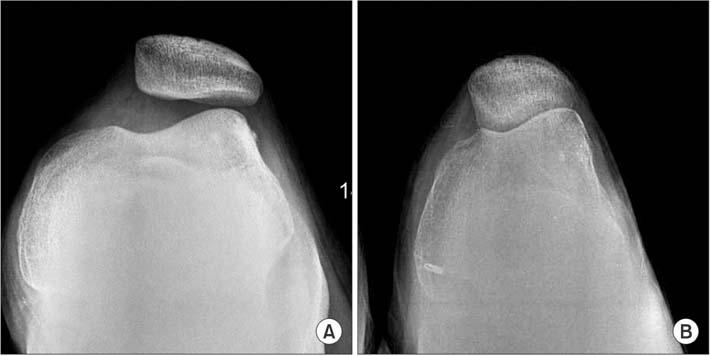Clin Orthop Surg.
2015 Dec;7(4):457-464. 10.4055/cios.2015.7.4.457.
Medial Patellofemoral Ligament Reconstruction for Recurrent Patellar Instability Using a Gracilis Autograft without Bone Tunnel
- Affiliations
-
- 1Department of Orthopaedic Surgery, School of Medicine, Kyungpook National University, Daegu, Korea. hskyung@knu.ac.kr
- KMID: 2360259
- DOI: http://doi.org/10.4055/cios.2015.7.4.457
Abstract
- BACKGROUND
Several tendon graft and fixation methods have been introduced in medial patellofemoral ligament (MPFL) reconstruction for recurrent patellar dislocation. The purpose of this study was to evaluate the results of MPFL reconstruction using a gracilis autograft fixation without bone tunnel in patients with recurrent patellar instability.
METHODS
Nine patients (four males and five females) diagnosed with recurrent patellar instability from July 2009 to January 2013 and had MPFL reconstruction using a gracilis autograft were included. The average age of the patients was 24.6 years (range, 13 to 48 years), and the average follow-up period was 19.3 months (range, 12 to 30 months). For every patient, femoral attachment was fixed using suture anchors securing the patella by suturing the periosteum and surrounding soft tissue. Clinical evaluation included the Kujala, Lysholm, and Tegner scores; in addition, patients were examined for any complication including recurrent dislocation. The congruence angle and patella alta were assessed radiologically before and after surgery.
RESULTS
The Kujala score improved from an average of 42.7 ± 8.4 before surgery to 79.6 ± 13.6 (p = 0.008) at final follow-up; the Lysholm score improved from 45.8 ± 5.7 to 82.0 ± 10.5 (p = 0.008); and the Tegner score improved from 2.8 ± 0.8 to 5.6 ± 1.5 (p = 0.007). The Insall-Salvati ratio changed from 1.16 ± 0.1 (range, 0.94 to 1.35) before surgery to 1.14 ± 0.1 (range, 0.96 to 1.29; p = 0.233) at the final follow-up without significance. The congruence angle significantly improved from 26.5°± 10.6° (range, 12° to 43°) before surgery to -4.0°± 4.3° (range, -12° to 5°; p = 0.008) at final follow-up. Subluxation was observed in one patient and hemarthrosis occurred in another patient 2 years after surgery, but these patients were asymptomatic.
CONCLUSIONS
We achieved good results with a patellar fixation technique in MPFL reconstruction using a gracilis autograft employing soft tissue suturing in patients with recurrent patellar dislocation.
MeSH Terms
-
Adolescent
Adult
*Autografts
Female
Humans
Knee Injuries/radiography/*surgery
Ligaments, Articular/radiography/*surgery
Male
Middle Aged
Muscle, Skeletal/surgery/transplantation
Patella/radiography/*surgery
Patellofemoral Joint/radiography/*surgery
Reconstructive Surgical Procedures/adverse effects/instrumentation/*methods
Retrospective Studies
Thigh/surgery
Young Adult
Figure
Reference
-
1. Nomura E, Horiuchi Y, Inoue M. Correlation of MR imaging findings and open exploration of medial patellofemoral ligament injuries in acute patellar dislocations. Knee. 2002; 9(2):139–143.
Article2. Sallay PI, Poggi J, Speer KP, Garrett WE. Acute dislocation of the patella: a correlative pathoanatomic study. Am J Sports Med. 1996; 24(1):52–60.3. Mountney J, Senavongse W, Amis AA, Thomas NP. Tensile strength of the medial patellofemoral ligament before and after repair or reconstruction. J Bone Joint Surg Br. 2005; 87(1):36–40.
Article4. Conlan T, Garth WP Jr, Lemons JE. Evaluation of the medial soft-tissue restraints of the extensor mechanism of the knee. J Bone Joint Surg Am. 1993; 75(5):682–693.
Article5. Desio SM, Burks RT, Bachus KN. Soft tissue restraints to lateral patellar translation in the human knee. Am J Sports Med. 1998; 26(1):59–65.
Article6. Nomura E, Inoue M. Hybrid medial patellofemoral ligament reconstruction using the semitendinous tendon for recurrent patellar dislocation: minimum 3 years' follow-up. Arthroscopy. 2006; 22(7):787–793.
Article7. Quirbach S, Smekal V, Rosenberger RE, El Attal R, Schottle PB. Anatomical double-bundle reconstruction of the medial patellofemoral ligament with a gracilis autograft. Oper Orthop Traumatol. 2012; 24(2):131–139.
Article8. Fink C, Veselko M, Herbort M, Hoser C. MPFL reconstruction using a quadriceps tendon graft: part 2: operative technique and short term clinical results. Knee. 2014; 21(6):1175–1179.9. Noyes FR, Albright JC. Reconstruction of the medial patellofemoral ligament with autologous quadriceps tendon. Arthroscopy. 2006; 22(8):904.e1–904.e7.
Article10. Witonski D, Keska R, Synder M, Sibinski M. An isolated medial patellofemoral ligament reconstruction with patellar tendon autograft. Biomed Res Int. 2013; 2013:637678.11. Cheatham S, Kolber MJ, Hanney WJ. Rehabilitation of a 23-year-old male after right knee arthroscopy and open reconstruction of the medial patellofemoral ligament with a tibialis anterior allograft: a case report. Int J Sports Phys Ther. 2014; 9(2):208–221.12. Berruto M, Ferrua P, Uboldi F, et al. Medial patellofemoral ligament reconstruction with bioactive synthetic ligament is an option: a 3-year follow-up study. Knee Surg Sports Traumatol Arthrosc. 2014; 22(10):2419–2425.
Article13. Amis AA, Firer P, Mountney J, Senavongse W, Thomas NP. Anatomy and biomechanics of the medial patellofemoral ligament. Knee. 2003; 10(3):215–220.
Article14. Ellera Gomes JL, Stigler Marczyk LR, Cesar de Cesar P, Jungblut CF. Medial patellofemoral ligament reconstruction with semitendinosus autograft for chronic patellar instability: a follow-up study. Arthroscopy. 2004; 20(2):147–151.
Article15. Schottle P, Schmeling A, Romero J, Weiler A. Anatomical reconstruction of the medial patellofemoral ligament using a free gracilis autograft. Arch Orthop Trauma Surg. 2009; 129(3):305–309.
Article16. Nomura E, Horiuchi Y, Kihara M. A mid-term follow-up of medial patellofemoral ligament reconstruction using an artificial ligament for recurrent patellar dislocation. Knee. 2000; 7(4):211–215.
Article17. Christiansen SE, Jacobsen BW, Lund B, Lind M. Reconstruction of the medial patellofemoral ligament with gracilis tendon autograft in transverse patellar drill holes. Arthroscopy. 2008; 24(1):82–87.
Article18. Schock EJ, Burks RT. Medial patellofemoral ligament reconstruction using a hamstring graft. Oper Tech Sports Med. 2001; 9(3):169–175.
Article19. Nomura E, Inoue M, Kobayashi S. Long-term follow-up and knee osteoarthritis change after medial patellofemoral ligament reconstruction for recurrent patellar dislocation. Am J Sports Med. 2007; 35(11):1851–1858.
Article20. Steiner TM, Torga-Spak R, Teitge RA. Medial patellofemoral ligament reconstruction in patients with lateral patellar instability and trochlear dysplasia. Am J Sports Med. 2006; 34(8):1254–1261.
Article21. Thaunat M, Erasmus PJ. Recurrent patellar dislocation after medial patellofemoral ligament reconstruction. Knee Surg Sports Traumatol Arthrosc. 2008; 16(1):40–43.
Article22. Arendt EA. MPFL reconstruction for PF instability: the soft (tissue) approach. Orthop Traumatol Surg Res. 2009; 95:8 Suppl 1. S97–S100.
Article23. Dejour H, Walch G, Nove-Josserand L, Guier C. Factors of patellar instability: an anatomic radiographic study. Knee Surg Sports Traumatol Arthrosc. 1994; 2(1):19–26.
Article24. Baumgartl F. Anatomical and clinical importance of the femoropatellar joint. Zentralbl Chir. 1966; 91(14):506–516.25. Feller JA, Amis AA, Andrish JT, Arendt EA, Erasmus PJ, Powers CM. Surgical biomechanics of the patellofemoral joint. Arthroscopy. 2007; 23(5):542–553.
Article26. Ahmad CS, Brown GD, Stein BS. The docking technique for medial patellofemoral ligament reconstruction: surgical technique and clinical outcome. Am J Sports Med. 2009; 37(10):2021–2027.
Article27. Petersen W, Zantop T. Eine neue methode zur patellaren fixation von MPFL-transplantaten. Arthroskopie. 2009; 22(3):237–240.
Article28. Drez D Jr, Edwards TB, Williams CS. Results of medial patellofemoral ligament reconstruction in the treatment of patellar dislocation. Arthroscopy. 2001; 17(3):298–306.
Article29. Lee HS, Choi JY, Ha JK, et al. Anatomical reconstruction of the medial patellofemoral ligament: development of a novel procedure based on anatomical dissection. J Korean Orthop Assoc. 2011; 46(6):443–450.
Article30. Lee KB, Song SY, Lee SJ, Son WS. Medial patellofemoral ligament reconstruction using the autogenous hamstring tendon for recurrent patellar instability: a preliminary report. J Korean Knee Soc. 2010; 22(2):93–101.
- Full Text Links
- Actions
-
Cited
- CITED
-
- Close
- Share
- Similar articles
-
- Medial Patellofemoral Ligament Reconstruction Using the Autogenous Hamstring Tendon for Recurrent Patellar Instability: A Preliminary Report
- Clinical Results of Anterior Cruciate Ligament Reconstruction: Bone-Paterllar-Tendon-Bone vs Hamstring Tendon Autograft
- Results and Factors Affecting Clinical Efficacy of Medial Patellofemoral Ligament Reconstruction Using a Gracilis Tendon Suture Technique
- Medial Patellofemoral Ligament Reconstruction: A Comprehensive Review
- Bone tunnel enlargement after anterior cruciate ligament reconstruction






